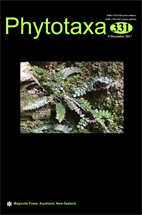Abstract
Three new lichenized fungal species in the family Graphidaceae are described from Northeast Brazil. Graphis alba has lirellae with a conspicuous white cover, eventually becoming striate, small, (sub-)muriform ascospores, and stictic acid. Halegrapha redonographoides features somewhat pseudostromatic ascomata with immersed lirellae, a completely carbonized excipulum, and small, submuriform ascospores, in combination with a norstictic acid chemistry. Thelotrema pachysporoides has an ecorticate, white thallus and produces brown, 7–13-septate, 25–35 × 7–10 µm large ascospores. The new species were found in an isolated remnant of Caatinga vegetation, at Fazenda Santa Maria da Lage, Poço Verde, Sergipe state, with additional material of one of the species also detected in the state of Tocantins.

